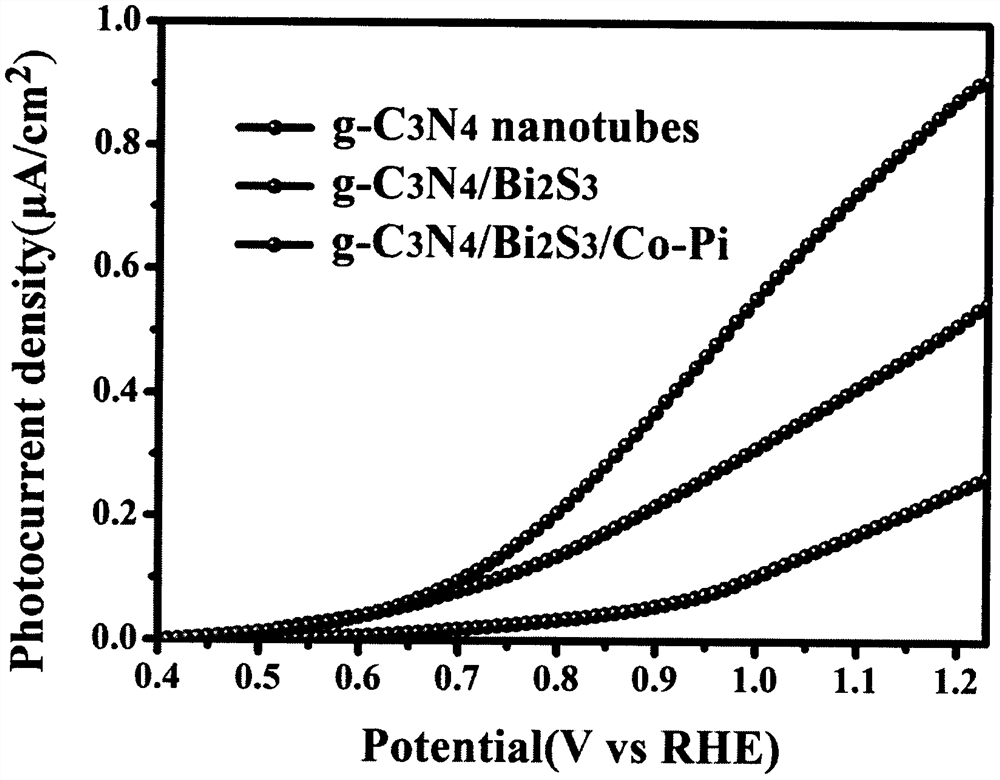Preparation method of g-C3N4 composite film material for photoelectrocatalysis
A composite film, photoelectric catalysis technology, applied in catalyst activation/preparation, chemical instruments and methods, chemical/physical processes, etc., can solve problems such as Eg increase and limitation
- Summary
- Abstract
- Description
- Claims
- Application Information
AI Technical Summary
Problems solved by technology
Method used
Image
Examples
Embodiment 1
[0019] A g-C for photocatalysis 3 N 4 The preparation method of composite film material, comprises the steps:
[0020] (1) Add 8g of dicyandiamide to 100mL of water under constant stirring, and then keep at 180°C for 4h by hydrothermal reaction. Cool the prepared solution to room temperature, centrifuge to obtain a white powder, dry it in a freezer for 20 h, take 6g of the powder and fill it into a 60×90mm ark, and press the FTO conductive glass on the ark with the conductive side facing down. transferred to a muffle furnace for processing, heated to 600 °C at a heating rate of 2 °C / min, kept for 4 h, and cooled to room temperature. You can get g-C with a rod-like structure attached to the FTO conductive glass 3 N 4 film.
[0021] (2) 0.48g Bi(NO 3 ) 3 ·5H 2 O was dissolved in 20 mL of ethylene glycol, and 0.48 g of Na 2 S·9H 2 O was dissolved in 20 mL of deionized water, and the two solutions were magnetically stirred for 0.5 h. Then immerse the sample prepared in ...
Embodiment 2
[0024] A g-C for photocatalysis 3 N 4 The preparation method of composite film material, comprises the steps:
[0025] (1) Add 5g of dicyandiamide to 100mL of water under constant stirring, and then keep at 180°C for 4h by hydrothermal reaction. Cool the prepared solution to room temperature, centrifuge to obtain a white powder, dry it in a freezer for 24 h, take 3 g of the powder and fill it into a 5 ml crucible, cover and press the FTO conductive glass on the crucible with the conductive side facing down, transfer It was processed in a muffle furnace, heated to 550°C at a heating rate of 2°C / min, then kept for 4 hours, and then cooled to room temperature. You can get g-C with a rod-like structure attached to the FTO conductive glass 3 N 4 film.
[0026] (2) 0.48g Bi(NO 3 ) 3 ·5H 2 O was dissolved in 20 mL of ethylene glycol, and 0.48 g of Na 2 S·9H 2 O was dissolved in 20 mL of deionized water, and the two solutions were magnetically stirred for 0.5 h. Then immerse ...
Embodiment 3
[0029] A g-C for photocatalysis 3 N 4 The preparation method of composite film material, comprises the steps:
[0030] (1) 6g of dicyandiamide was added to 100mL of water under constant stirring, and then kept at 180°C for 4h by hydrothermal reaction. Cool the prepared solution to room temperature, centrifuge to obtain a white powder, dry it in a freezer for 18 h, take 4 g of powder and fill it into a 5 ml crucible, cover and press the FTO conductive glass on the crucible with the conductive side facing down, transfer It was processed in a muffle furnace, heated to 600°C at a heating rate of 2°C / min, then kept for 4 hours, and then cooled to room temperature. You can get g-C with a rod-like structure attached to the FTO conductive glass 3 N 4 film.
[0031] (2) 0.48g Bi(NO 3 ) 3 ·5H 2 O was dissolved in 20 mL of ethylene glycol, and 0.48 g of Na 2 S·9H 2 O was dissolved in 20 mL of deionized water, and the two solutions were magnetically stirred for 0.5 h. Then imme...
PUM
 Login to View More
Login to View More Abstract
Description
Claims
Application Information
 Login to View More
Login to View More - Generate Ideas
- Intellectual Property
- Life Sciences
- Materials
- Tech Scout
- Unparalleled Data Quality
- Higher Quality Content
- 60% Fewer Hallucinations
Browse by: Latest US Patents, China's latest patents, Technical Efficacy Thesaurus, Application Domain, Technology Topic, Popular Technical Reports.
© 2025 PatSnap. All rights reserved.Legal|Privacy policy|Modern Slavery Act Transparency Statement|Sitemap|About US| Contact US: help@patsnap.com

